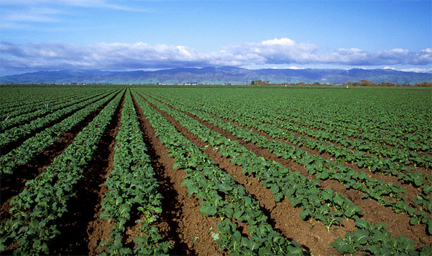1) Agriculture is a major Californian industry. The amount of land devoted to farming and ranching in California remains at 25.4 million acres. (California Agriculture statistics, Crop year 2012) Approximately 33 million acres in California are forests. (Division of Agriculture and Natural Resources, University of California) For urban land, 5.1% takes up of the state's land area. (Urban Forest Data)
2)
Polyculture farming: agricultural method of planting multiple crops in the same field
Polyculture pros:-faster sowing
-reduces pests and disease outbreaks
-better flavour and nutrition
-natural resources used more efficiently
-better polination
-improved yields
Polyculture cons:
-slower harvest
-difficult to calculate income and predict results
-seed loss/high up-front seed costs
-difficult to control
Monoculture farming: agricultural method involves planting one species of crop on the same piece of land repeatedly

Monoculture pros:
-the field is in better position to provide maximum output for particular crop
-helps keep down farming costs
-knowledge of single species if sufficient for good crop
-is convenient
-easier
-less competition of sunlight, nutrients, and space from other species
Monoculture cons:
-does not support other flora and fauna
-disease can spread to whole crop *all plants
-limits chance of taking advantage of other nutrients in soil
-limited food options
-reduces nitrogen composition in soil
-soil fertility diminishes at a faster rate
-time consuming
Slash and burn: agriculture technique which involves cutting and burning forests or woodlands to create fields

Slash and burn pros:
-returns nutrients to soil
-controlled burn reduces fire risk of debris left on farm land
-cheaper to burn the debris on-site
-burns may be used to scare unwanted animals out
-may eliminate pests
Slash and burn cons:
-is a fire hazard
-site preparation may be longer
-may lead to erosion or leaching of nutrients
-releases greenhouse gases
-animals may be killed
-get out of control and cause damage; endanger lives
3) Sustainable practices involve a variety of approaches. Strategies must take account topography, soil characteristics, climate, pests, local availability of inputs and individual grower's goals. Diversified farms are usually more economically and ecologically resilient, which is why California is mostly pro polyculture. As previously mentioned agriculture is a main industry of California and is crucial to the economy. The risk of monoculture is that the loss of crop in any one year could put a farm out of business and/or seriously disrupt the stability of a community dependent in that crop. By growing a variety of crops they are less susceptible to the radical price fluctuations associated with changes in supply and demand.
California grows over 400 different crops, some grown nowhere else in the nation. Crops include grapes, almonds, strawberries, oranges, and walnuts. The most important vegetable crops grown in the state are lettuce and tomatoes. Half the nation's fruits, vegetables, and nuts come from California.
With the current California water crisis, the agriculture is in scrutiny right now. The current drought situation is jeopardizing all their advances. The governor is also demanding 25% reduction in water use. Agriculture is under intense pressure to do more especially since the governor's mandatory cuts didn't include agriculture.